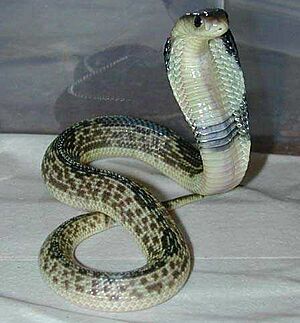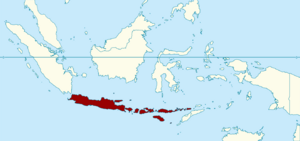Javan spitting cobra facts for kids
Quick facts for kids Javan spitting cobra |
|
|---|---|
 |
|
| Conservation status | |
| Scientific classification | |
| Genus: |
Naja
|
| Species: |
sputatrix
|
 |
|
| Distribution of the Javan spitting cobra. | |
| Synonyms | |
|
|
The Javan spitting cobra (Naja sputatrix) is also known as the Indonesian cobra or Komodo spitting cobra. This amazing snake is a type of cobra found in Indonesia. You can find it on islands like Java, Bali, Lombok, Sumbawa, Flores, and Komodo.
Contents
What's in a Name?
The Javan spitting cobra's scientific name is Naja sputatrix. It belongs to the Naja group, which is the scientific name for cobras. The word Naja comes from an old Indian language called Sanskrit. It means "cobra."
The second part of its name, sputatrix, comes from a Latin word. This word means "spitter." This name is perfect because this cobra is known for its ability to spit venom! A German scientist named Friedrich Boie first described this snake in 1827.
What Does It Look Like?
The Javan spitting cobra is a medium to large snake. It can grow to about 1.3 meters (4.3 feet) long on average. Some can even reach up to 1.85 meters (6 feet)!
When this snake feels scared, it can flatten its neck ribs. This makes a wide, flat "hood" that looks very impressive. Its body is usually yellowish, brown, or black. Young cobras often have cool patterns on their throats. Sometimes, they have a V-shaped mark on their hood.
Where Does It Live?
This cobra calls several Indonesian islands home. You can find it on Java and the Lesser Sunda Islands. These include Bali, Lombok, Sumbawa, Komodo, Flores, Lomblen, and Alor.
Scientists are still checking if it lives on other islands like Timor and Sulawesi. These snakes can live in many places. They are found from sea level up to high altitudes, like 650 meters (2,130 feet) on Komodo Island.
Home and Habits
The Javan spitting cobra loves tropical forests and wet areas. But it's also very good at living in different places. You might find it in dry woodlands or even on cultivated hills. On Komodo Island, it lives in dry grasslands and forests.
This snake is quite defensive. If it feels threatened, it will quickly spit its venom. It is a nocturnal animal, meaning it is active at night. It mostly hunts small mammals like rats and mice. But it also eats frogs, other snakes, and lizards.
Reproduction
Javan spitting cobras usually mate during the dry season, from August to October. Females lay their eggs at the end of the dry season or when the wet season begins.
A female cobra can lay between 13 and 19 eggs at a time. On average, a clutch has about 16 eggs. Some Javan females can even lay up to 36 eggs! The eggs take about 88 days to hatch. Once the baby cobras hatch, they are completely independent and can take care of themselves.
Conservation Status
The Javan spitting cobra is listed under Appendix II by CITES. This means it's not currently in danger of disappearing. However, its trade needs to be carefully watched. This helps make sure that using these snakes doesn't harm their numbers in the wild.
People sometimes collect these snakes for their skins. They are also occasionally found in the pet trade. Protecting their habitats and controlling trade helps keep them safe.
Venom
The Javan spitting cobra's venom is very strong. It contains special proteins and enzymes. The main parts of its venom are called cardiotoxins. These can affect the heart and cells.
It also has neurotoxins, which affect the nervous system. The venom can also make blood harder to clot. Even though its venom is potent, very few people have died from bites from this species.


